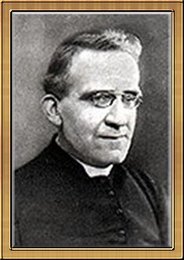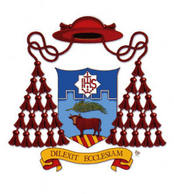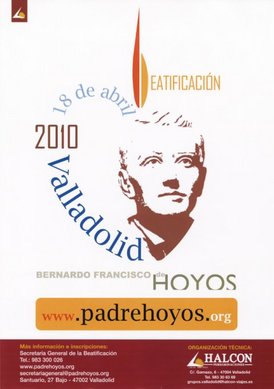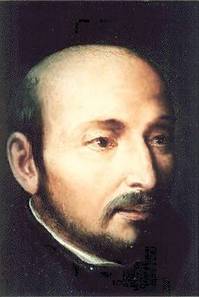 470 years ago on this date, another Easter Sunday, Ignatius of Loyola and his first companions elected Ignatius as the first superior of the new group, a year following the Church’s approval of the society. Just two days before his election, the companions went to the Basilica of Saint Paul outside the Walls to profess their vows.
470 years ago on this date, another Easter Sunday, Ignatius of Loyola and his first companions elected Ignatius as the first superior of the new group, a year following the Church’s approval of the society. Just two days before his election, the companions went to the Basilica of Saint Paul outside the Walls to profess their vows.
Tag: Jesuits
David L. Fleming, SJ, RIP
Today has been a day of death it seems. I started the day with a funeral of a 8 year old who died the other day of cancer.
Religious Orders talk about their purpose at Notre Dame Univ
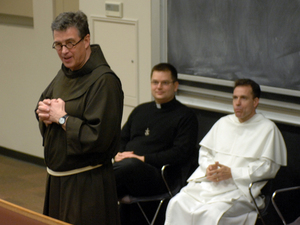 Last week at the University of Notre Dame (my alma mater) members of the various religious orders along with a secular priest, spoke about their place in the Church. In church lingo: they spoke about their charism (the diivne gift). As you know ND was founded and continues to be sponsored by the Congregation of Holy Cross (CSC) but through the years members of religious orders like the Franciscans, Jesuits and Dominicans (among others) have worked and/or studied at ND. The richness ot the women religious ought to be explored at some point.
Last week at the University of Notre Dame (my alma mater) members of the various religious orders along with a secular priest, spoke about their place in the Church. In church lingo: they spoke about their charism (the diivne gift). As you know ND was founded and continues to be sponsored by the Congregation of Holy Cross (CSC) but through the years members of religious orders like the Franciscans, Jesuits and Dominicans (among others) have worked and/or studied at ND. The richness ot the women religious ought to be explored at some point.
The Thought of Henri Bremond
In the current
issue of La Civiltà Cattolica, Jesuit Father Antonio Spadaro wrote an
interesting essay, “The Thought of Henri Bremond.” Matters pertaining to faith
and reason, faith and culture interest me perhaps you. At least that’s what I
hope if you are a frequent reader of the Communio blog. Henri Bremond
(1865-1933) is a former a Jesuit priest, literary scholar and was in the middle
of the Modernist crisis. His literary output was terrific. Bremond was a member
of the illustrious Académie Française succeedingm(elected in 1923 holding seat
number 36). France also awarded the Lé d’honneur. The summary:
An attempt to
overcome the gap between faith and culture – In the years that saw the rise of
surrealism, of Freudian thought and of the modernist crisis, Henri Bremond
captured the separation that was growing between theology and culture
sanctioned by the Enlightenment. Bremond suffered in trying to find a
compromise in terms of language, seeking to show to a cultured audience the
best results of a religious sensibility and sought to show to his Catholic
readers the religious value of «profane» literature. Seeing the similarities
between a mystical and a poetic inspiration, he concluded that “it is up to the
mystic to explain the poet,” reversing a common axiom. The article, on the
occasion of the reissue of his Prayer and poetry, absent from Italian
bookstores for three decades, presents the main insights of the priest,
academician of France.
New Heaven, New War
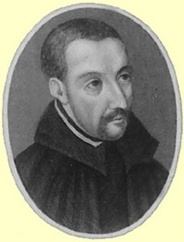 One of my favorite 16th century recusant poets is Saint Robert Southwell, an English Jesuit who preached the gospel in very trying circumstances. Southwell chose the obedience to be a Catholic priest in a country that outright persecuted Catholics and their priests. Ordained a Jesuit priest in 1584, his personal, theological and ministerial imagination, his human and divine calling, was to respond positively to a letter of the Superior General of the Society of Jesus of February 20, 1585 looking for missionaries to England. Southwell knew that his positive response to his religious superior would very likely end in martyrdom. Saint Robert Southwell’s poetry is challenging for the 21st century ear but worth the work of coming to understand his art and message. One such poem is “New Heaven, New War” expressing the Mystery of the Incarnation of God in history, the birth of Jesus.
One of my favorite 16th century recusant poets is Saint Robert Southwell, an English Jesuit who preached the gospel in very trying circumstances. Southwell chose the obedience to be a Catholic priest in a country that outright persecuted Catholics and their priests. Ordained a Jesuit priest in 1584, his personal, theological and ministerial imagination, his human and divine calling, was to respond positively to a letter of the Superior General of the Society of Jesus of February 20, 1585 looking for missionaries to England. Southwell knew that his positive response to his religious superior would very likely end in martyrdom. Saint Robert Southwell’s poetry is challenging for the 21st century ear but worth the work of coming to understand his art and message. One such poem is “New Heaven, New War” expressing the Mystery of the Incarnation of God in history, the birth of Jesus.
Urbano Cardinal Navarrete Cortés, SJ, RIP
 Urbano Cardinal Navarrete Cortés, SJ, 90, died today. The Mass of Christian Burial is scheduled for November 24; the Dean of the College of Cardinals, Angelo Cardinal Sodano will celebrate the Sacrifice of the Mass and His Holiness will preside over the Final Commendation and give a valediction.
Urbano Cardinal Navarrete Cortés, SJ, 90, died today. The Mass of Christian Burial is scheduled for November 24; the Dean of the College of Cardinals, Angelo Cardinal Sodano will celebrate the Sacrifice of the Mass and His Holiness will preside over the Final Commendation and give a valediction.
Fr Allen P. Novotny, SJ RIP
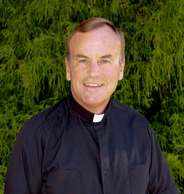 At this moment, family, friends, and Jesuits are gathering for the Mass of Christian Burial for the Reverend Father Allen P. Novotny, SJ, 58, President of Gonzaga College High School, Washington, DC. I mention this because I had the privilege of living with Allen for a year and liked him very much. I’ve been saddened since hearing the news on October 27th that Allen died earlier that day from a mutual friend. I was unable to make the funeral Mass but have not ceased praying for Allen’s peace and God’s mercy upon Allen and the rest of us. Eternal rest, dear friend.
At this moment, family, friends, and Jesuits are gathering for the Mass of Christian Burial for the Reverend Father Allen P. Novotny, SJ, 58, President of Gonzaga College High School, Washington, DC. I mention this because I had the privilege of living with Allen for a year and liked him very much. I’ve been saddened since hearing the news on October 27th that Allen died earlier that day from a mutual friend. I was unable to make the funeral Mass but have not ceased praying for Allen’s peace and God’s mercy upon Allen and the rest of us. Eternal rest, dear friend.
The lost Caravaggio, The Martyrdom of St Lawrence, found with the Jesuits
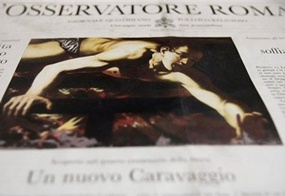 The art world is abuzz due to an article in L’Osservatore Romano on Sunday stating that a “lost Caravaggio” may now be found.
The art world is abuzz due to an article in L’Osservatore Romano on Sunday stating that a “lost Caravaggio” may now be found.
The as yet unauthenticated painting, “The Martyrdom of St Lawrence,” owned by the Society of Jesus, is thought to be a Caravaggio because it has the hallmarks of a Caravaggio, including dramatic lighting effects, the L’Osservatore Romano said. “Certainly it’s a stylistically impeccable, beautiful painting,” the article stated in its Sunday edition. “One can’t but be reminded of works like the Conversion of St Paul, the Martyrdom of St Matthew and Judith and Holofernes.”
Michelangelo Merisi da Caravaggio is the acknowledged pioneer of the Baroque painting technique of contrasting light and dark known in Italian as “chiaroscuro.” It is estimated that about 80 of the painter’s works are extant. He was born in Milan and trained there under Titian. Many are also aware of the artist’s wild lifestyle and the alleged murder he committed of a man in a brawl and then fled Rome. Moreover, Caravaggio’s mysterious death in 1610 has long intrigued scholars. Among the theories of his disappearance are that he was killed on a deserted Tuscan beach or collapsed there due to an illness. Italian anthropologists announced last month they had found the famous artist’s mortal remains. The artist’s club is observing the 400th anniversary of the artist’s death.
Leave it to the Jesuits to have at least two Caravaggio’s!
The death of Jesuit psychoanalyst, Fr William W. Meissner
 I haven’t seen him in nearly 7 years, but I was very sad to hear of the death of Jesuit Father William W. Meissner, 79, the other day. A New York Province Jesuit priest who was trained as a psychiatrist at Harvard, Bill was a great man in my mind with lots of quirks, probably too many to speak of. Bill was the sort of man who didn’t suffer fools gladly; he was one of those Jesuits who worked very hard and play well but didn’t do pastoral work. His life as a priest is was dedicated to the ministry of research and teaching. All the same, I loved being on vacation with Bill and I remember fondly our many serious conversations. When I studied in Boston in the early 1990s he gave a series of lectures on the psychology of Saint Ignatius of Loyola which I attended and found incomprehensible; the lectures eventually became a book, Ignatius of Loyola: The Psychology of a Saint, you may have seen it. I have to admit that psychoanalyzing a dead saint is a bit weird –with or without a couch– but fascinating nonetheless because we got a glimpse into the heart and mind of terrific saint.
I haven’t seen him in nearly 7 years, but I was very sad to hear of the death of Jesuit Father William W. Meissner, 79, the other day. A New York Province Jesuit priest who was trained as a psychiatrist at Harvard, Bill was a great man in my mind with lots of quirks, probably too many to speak of. Bill was the sort of man who didn’t suffer fools gladly; he was one of those Jesuits who worked very hard and play well but didn’t do pastoral work. His life as a priest is was dedicated to the ministry of research and teaching. All the same, I loved being on vacation with Bill and I remember fondly our many serious conversations. When I studied in Boston in the early 1990s he gave a series of lectures on the psychology of Saint Ignatius of Loyola which I attended and found incomprehensible; the lectures eventually became a book, Ignatius of Loyola: The Psychology of a Saint, you may have seen it. I have to admit that psychoanalyzing a dead saint is a bit weird –with or without a couch– but fascinating nonetheless because we got a glimpse into the heart and mind of terrific saint.
Bernardo de Hoyos beatified
Today, in Valladolid, Spain, Father Bernardo de Hoyos (1711-1735) was beatified. I previously mentioned Father de Hoyos on this blog. Here is a précis of Father Adolfo Nicolás’ letter to the Jesuits. The full text of the letter can be read here Bernard de Hoyos letter.pdf

